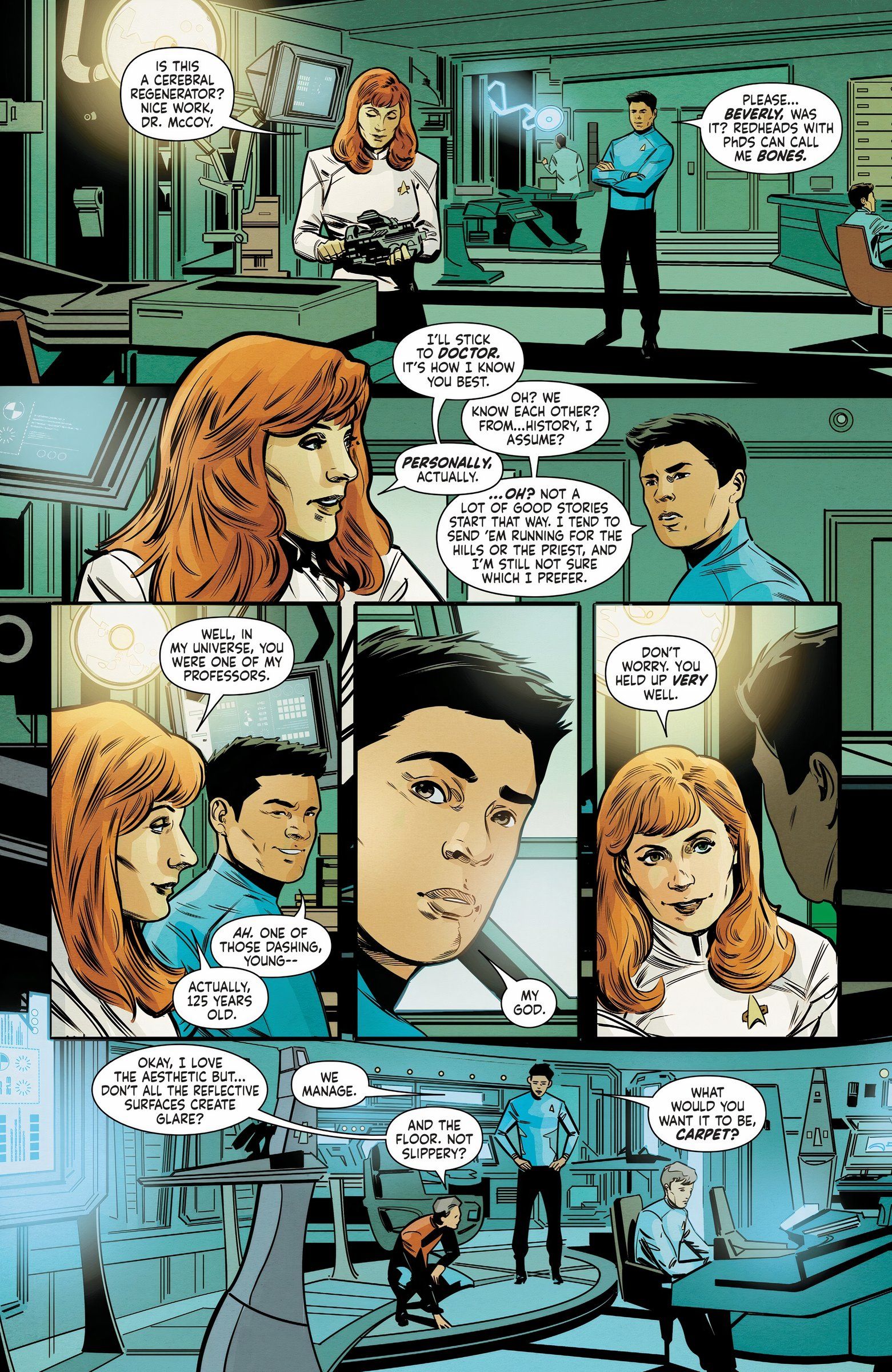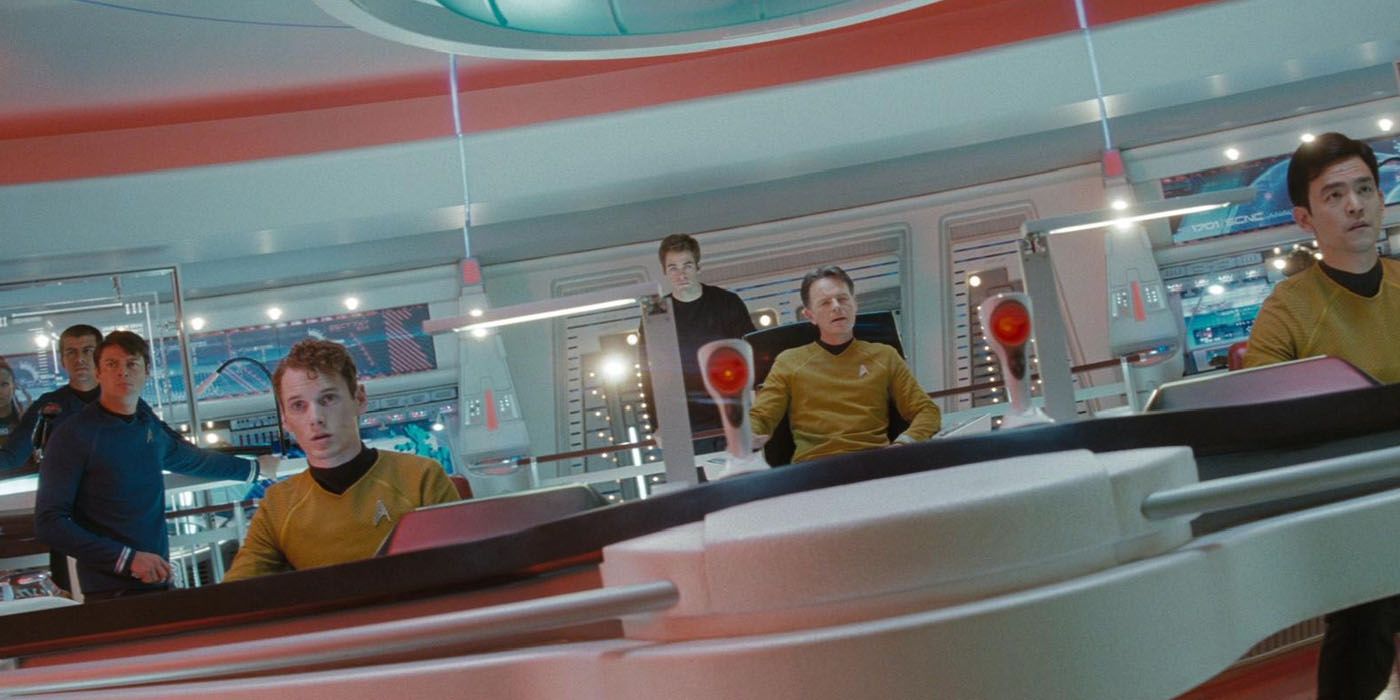Star Trek called out JJ Abrams’ 2009 reboot of the franchise with a hilarious dig. After a string of commercial and critical duds in the early 2000s, Paramount Pictures brought JJ Abrams in to revitalize the ailing franchise. The result, 2009’s Star Trek, was highly stylistic, and one aspect of the films gets a hilarious call-out in Star Trek #26, part two of the epic “When the Walls Fell” storyline.

On the bridge, Tom Paris asks Sulu about the reflective surfaces creating a glare, to which he replies: “We manage.”
Star Trek #26 was written by Jackson Lanzing and Collin Kelly and drawn by Angel Hernandez. Captain Sisko and a contingent of officers from the Theseus beam aboard the Kelvin Timeline Enterprise. The two crews must work together to save the Kelvin Universe from the wave of destruction Lore has unleashed. As the two crews get to know each other, they cannot help but to notice how much more futuristic this Enterprise is than theirs. On the bridge, Tom Paris asks Sulu about the reflective surfaces creating a glare, to which he replies: “We manage.”

Star Trek's Kelvin Timeline Was Shiny
Star Trek's Lens Flares Were Cool, But Overdone
Paris’ quip about reflective surfaces creating distracting glares is a direct call-out to a visual flourish director JJ Abrams imparted upon the two franchise films he made: 2009’s Star Trek and 2013’s Star Trek: Into Darkness. These two films, made by Paramount to jump start the Star Trek franchise, not only recast younger actors in the roles of Kirk, Spock and Uhura, but also significantly updated the look and appearance of the technology used by Starfleet. The movies, with large budgets, made Star Trek’s futuristic technology look just that; futuristic.
The aesthetic Abrams cultivated in the movies was sleeker and more streamlined–and bright and shiny as well. The sets were so shiny, in fact, that the film’s lighting created “lens flares” throughout, to the point where it became distracting for some fans. Jokes and memes about these lens flares circulated in online Star Trek forums. While the lens flares were a nice touch in some scenes, and did help drive home much more technologically advanced the Kelvin Universe was, the fact remains they were overused. And now, at the Kelvin Universe’s possible end, this gets a hilarious call-out.
Other Aspects of the Kelvin Enterprise Get Called Out As Well
The Kelvin Enterprise Was Strangely Familiar

The rampant lens flares are not the only aspect of the bridge getting a callout in Star Trek #26. Right after cracking a joke about the reflective surfaces, Tom Paris asks if they ever slip on the bridge’s floor. An incredulous Sulu asks Paris if he would prefer a carpet–a dig at the starships of the 24th century. The bridges of the Enterprise, Defiant and Voyager all featured carpet in some places, a huge changeover from the bridges of Kirk’s era. The Kelvin Enterprise is still in the 23rd century, and the carpet on the bridge may be just around the corner.
In addition to a sleeker, more high-tech looking bridge, the rest of the Enterprise received a makeover as well–and Star Trek #26 calls these differences out too. As the two Scottys tour Engineering, the older, Prime Scotty notices all the tubes flowing through the facility. The Kelvin Enterprise’s Engineering section is one of the few areas of the ship that was not streamlined, and is more cramped than its Prime counterpart. Finally, Doctor Crusher commented on the differences between Kelvin McCoy and the one she had as an instructor at the Academy, including a remarkable bit of technology he created.
Star Trek's Kelvin Era Influenced Modern Trek Shows
JJ Abrams Brought an Outsider's Perspective to Star Trek--And Saved the Franchise in the Process
JJ Abrams did not direct the third Star Trek Kelvin film, due to his obligations with Star Wars . Justin Lin, of the Fast and Furious franchise, directed it instead.
The three Kelvin Star Trek films, while controversial among long-time fans, succeeded in their goal of keeping the franchise alive during a “wilderness years” phase. After the critical and box-office failure of Star Trek: Nemesis, and the premature cancelation of Star Trek: Enterprise, new voices were needed in the franchise, and JJ Abrams came to the rescue. Abrams, who admitted to not being that big of a Trek fan when he first signed on, brought an outsider’s perspective to Star Trek. He also brought with him Alex Kurtzman, who now oversees the current crop of Star Trek shows on Paramount +.
While there have been no lens flares on Discovery or Strange New Worlds , it is not difficult to see the visual influence the Kelvin Universe has had on the franchise.
While the innovations the Kelvin Star Trek films introduced were controversial among fans, they have nevertheless influenced the look and aesthetic of the modern shows, such as Picard, Discovery and Strange New Worlds. Thanks to advances in film making technology, the newer Star Trek shows look more cinematic than their predecessors, and recall the spirit of the Kelvin movies. While there have been no lens flares on Discovery or Strange New Worlds, it is not difficult to see the visual influence the Kelvin Universe has had on the franchise.
Prime Timeline Star Trek Seems Almost Primitive Next to the Kelvin Ships
Will The Kelvin Enterprise Crew Ever Return?

And now the Kelvin Universe’s instantly recognizable appearance gets a call-out in Star Trek #26. The Theseus crew, outsiders in the Kelvin Universe, instantly notice the differences between the two. The Defiant, despite being from a century later than the Kelvin Enterprise, appears “low-tech” next to it, and this puzzles Sisko and his crew. While they call out the differences in appearances, they do not get time to celebrate them as the Kelvin Universe falls prey to Lore’s crusade of chaos and destruction. Paris’ call-out of Star Trek’s Kelvin Universe reinforces how important and influential it was.



